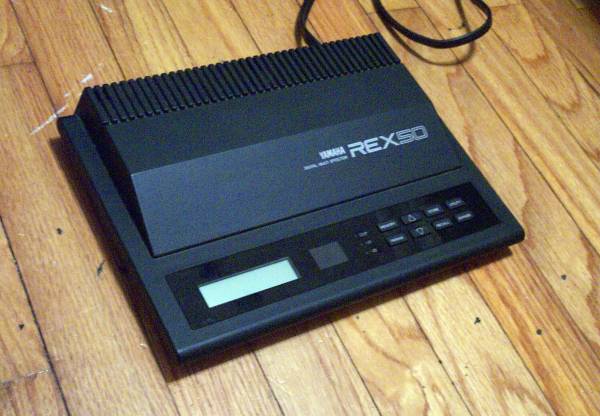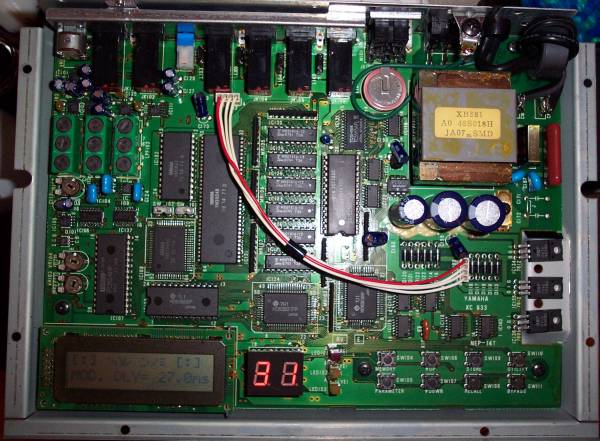Yamaha REX50- owned from August 2003-present, bought for $30 (!)
I didn't really want to get anything new but when I saw the prices that these things were going for on ebay I became very interested. After doing a little research I concluded that they have many of the same effect algorithms as the SPX90, which is very popular and still worth money (well, $200). I looked through the user manual and it seemed pretty good. So I bought one, and while it's not great, it was definately worth it, and I've been using it a lot more than the stupid REV100.
It's an ugly, strangely-shaped desktop unit (it seemed Yamaha liked making those in the 80's- the TX7 and TQ5 also spring to mind as particularly strange case designs) with 30 presets and 60 user slots. It was made in 1987 (on startup it says that mine is using OS version 1.2, dated August 1987), and the sampling rate is only 31.25kHz.
There are 4 different reverb algorithms- hall (which sounds somewhat grainy), room (which sounds smoother), vocal (which sounds very grainy), and plate (which sounds smoother but more metallic). The adjustable parameters are decay (0.3 to 99 seconds!), high (0.1 to 1.0), pre-delay (0.1 to 50.0 ms), highpass filter (THRU to 1.0kHz), and lowpass filter (THRU to 1.0kHz). Overall the reverbs have a nice warm and fairly smooth quality that I really like. Then there's an early reflections algorithm with 4 types- Hall, Random, Reverse, and Plate. It acts as a sort of short multitap delay, and the type determines the pattern of the "early reflections". It's not very useful. Other parameters are room size (0.1 to 20.0), liveness (0 to 10), pre-delay (0.1 to 400.0 ms), and lowpass filter (THRU to 1.0kHz). There are two delay algorithms- a two-tap stereo delay (maximum delay time 500ms) and a truly independent stereo delay (maximum delay time 250ms for each channel). Other parameters include feedback (can be positive or negative) for each channel, and high (0.1 to 1.0). Stereo flange sounds pretty good and has some nice versitile settings. Its parameters are mod frequency (0.1 to 20.0 Hz), mod depth (0 to 100%), mod delay (0.1 to 100.0 ms), and feedback. Chorus sounds pretty nice, its parameters are mod frequency (0.1 to 20.0 Hz), mod depth (0 to 100%), and AM depth (0 to 100%, sort of a panning effect). Stereo phasing is another delay-based effect that really sounds more like a less-pronounced flange effect, nothing at all like real phasing. Its parameters are mod frequency (again 0.1 to 20.0 Hz), mod depth (0 to 100%), and mod delay (0.1 to 8.0 ms). Symphonic is to me the best sounding of the modulated delay-based effects. Its parameters are just mod frequency (0.1 to 20.0 Hz) and mod depth (0 to 100%). After that there's an ADR noise gate, with adjustable trigger level (1 to 100), trigger delay (-100 to +100 ms), trigger mask (5 to 32,000 ms - it's the time until gate can be retriggered), attack time (5 to 32,000 ms), decay time (5 to 32,000 ms), decay level (0 to 100%), hold time (1 to 30,000 ms), release time (5 to 32,000 ms), and midi trigger (on or off, triggers gate with midi note messages). The compressor has parameters for attack (1 to 40 ms), release (10 to 2000 ms), threshold (-48 to -6 dB), ratio (1.0 to 20.0), detect delay (-50.0 to 50.0 ms), and delay time (0.1 to 400.0 ms). Reverb and gate is a typical gated reverb, though it isn't specified which reverb algorithm is used here. Parameters include reverb time (0.3 to 99 seconds), high (0.1 to 1.0), pre-delay (0.1 to 50.0 ms), highpass filter (THRU to 1.0 kHz), lowpass filter (THRU to 1.0 kHz), gate trigger level (1-100), hold time (1 to 30.000 ms), release time (5 to 32,000 ms), and midi trigger (on or off). There are three pitch shifter algorithms: The first consists of a mono pitch shift, controllable by midi, fed into a 400 ms delay with feedback. The second consists of two mono pitch shifts with 400 ms delays but no feedback or midi. The third has two independent pitch shifts and a 200 ms delay for each channel. Pitches can be adjusted + or - 1 one octave, with a fine tuning control in one cent steps. Extreme pitch shifts tend to sound pretty weird, and with feedback the first algorithm can actually self-oscillate. Next is distortion. It's pretty versitile but it has a tendency to alias sometimes because of the fairly low sample rate. Parameters are distortion amount (0 to 100%), midrange EQ frequency (5 steps from 560 to 2000 Hz), midrange EQ gain (-12 to +12 dB), trebel gain (-12 to +12 dB), trigger level (1 to 100), and release time (5 to 32,000 ms). The rest of the effects are combination effects- distortion plus something else, usually with the distortion part somewhat simplified. Distortion can be paired with reverb (hall or plate algorithms), early reflections, delay (either algorithm), flange, chorus, or symphonic.
Editing isn't much fun because all the programming is done with just 8 buttons. There's no data slider so all the values have to be incremented. It's pretty tedious but at least there aren't that many parameters to edit. Patch name editing is nice because of the variety of characters. There are upper and lower case letters, numbers, lots of punctuation, and a bunch of japanese characters- in total probably more than on any other synth or effect processor I have.
Inside, everything is contained on one small board. The CPU is a Hitachi 6303. There are 3 custom chips: YM3807, YM3901 (main DSP chip, also used in other effects processors and the DSP-1 home theater sound processor thing, which actually included most of the same effect algorithms, so you could listen to cds with reverb or flange I guess), and a YM3804. The DAC is a PCM54HP, and there are 3 adjustable lowpass anti-alias filters (one for intput and 2 for output, it would seem).
Overall it sounds good, particularly the reverb and symphonic algorithms. Some of the algorithms aren't particularly useful (noise gate), or well-featured (delays), but there are also some nice things that aren't covered in any of my other effect processors (pitch shift and distortion). It doesn't do chained effects like the Quadraverb, except the distortion + effect algorithms, but for $30 it's still a really, really good buy. Similar models like the SPX50D and SPX90 have some different features and algorithms, and they're 1-unit rackmount instead of ugly tabletop things, so they might be worth looking into for a bit more money.
pictures:


links:
Yamaha has user manuals for nearly all of their products available here: Yamaha Manual Library (English)
back to synth index